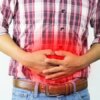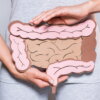
What Is IBS?
IBS (irritable bowel syndrome) is a common digestive disorder that affects the large intestine, or colon. It’s not a disease, but rather a collection of symptoms that are outlined in the ROME IV criteria.
These criteria mention that a diagnosis of IBS can only be given in the absence of a disease. This means that other conditions such as Crohn’s disease or coeliac disease are ruled out, and a diagnosis of IBS is likely to be given. [Source: Rome Foundation]
While this doesn’t provide a reason for symptoms, there are a range of possible underlying causes for those with IBS symptoms.
These underlying causes of IBS symptoms vary from person to person. It’s also possible for more than 1 of these to be an issue for those with IBS.
These underlying issues of IBS can include:
- Low-grade inflammation
- Dysbiosis
- SIBO
- Food intolerances
- Vitamin deficiencies
- Stress and disrupted sleep
- Infections [Source: MDPI]
There are clear strategies that can be followed to help to reduce symptoms of IBS. However, another element of the approach that can (and should) be considered is to identify and address the underlying issue in the gut itself.
Who Gets IBS?
In general, IBS is more common in women than men. It’s also more likely to occur in people under the age of 50 and can affect people of all ethnic backgrounds. However, there are some groups that are at higher risk for developing IBS. [Source: PubMed]
If you have a family history of irritable bowel syndrome (IBS). If your parents or siblings have been diagnosed with IBS you may be at an increased risk for developing IBS. [Source: PubMed]
A significant risk factor for developing IBS is an event of food poisoning or gastroenteritis. This can be due to a low-grade inflammatory response that continues once the infection has subsided.
This has been found to increase the risk of developing IBS by 600%, with the increase in risk lasting for a 2-3 year time period. [Source: PubMed]
Stress and disrupted sleep can also lead to an increased risk of developing the symptoms of IBS. This can lead to alteration in the gut microbiome (referred to as dysbiosis) as well as changes in bowel motility.
It’s also known that poor sleep can increase pain perception, leading to the symptoms of IBS becoming more uncomfortable. This is especially true for those with IBS-C (IBS with constipation) [Source: PubMed]
IBS Diet Plans
For anyone with (IBS) irritable bowel syndrome, food becomes a big focus. With restricted diets being more and more common, there can be lots of questions about what to eat and what to avoid to identify triggers and improve IBS symptoms.
Specific trigger foods can lead to bloating, cramping or fluctuation in bowel patterns (e.g constipation or diarrhoea) working to identify these can help manage symptoms of IBS. However, there is a balance to be struck regarding where to start with the diet, how restrictive to make it and to address the root cause of IBS symptoms. [Source: NHS]It is also common for either certain foods to be tolerated one day and an issue the next as well as triggers remaining a mystery to most patients.
The approach to creating a diet or dietary guidelines for IBS is highly personalised and depends on 3 main factors.
- The current diet/eating pattern
- The severity of IBS symptoms
- The underlying imbalance/root cause in the gut
These 3 factors can influence the direction of the diet and meal plan.

Rather than creating a restricted diet plan for IBS to avoid specific foods, simply improving the diet and moving towards what is considered a Mediterranean diet can improve symptoms of IBS.
As the Mediterranean diet has been associated with a reduced risk of a wide range of diseases, this diet plan is also working to address and improve the balance of the gut and the gut microbiome. [Source: PubMed]
This diet can improve the gut in several ways which involves introducing a range of fermentable fibres into the gut, that feed the gut microbiome. As well as this, this diet plan can also introduce compounds called polyphenols that further support the gut microbiome and have an anti-inflammatory effect on the gut lining.
Due to the imbalances in the gut microbiome and low-grade inflammation both being seen in IBS, supporting these areas may be an appropriate approach for many with IBS. [Source: PubMed]
However, in susceptible individuals, this increase in fibre may increase IBS symptoms. This will be covered in more detail later in this article.
IBS Triggers Foods
Most people with IBS feel food is a trigger, but not all understand what that trigger is. In fact, many with IBS feel that the same food can cause a reaction on one day, and be ok the next day. This is not uncommon.
Many with IBS, also find that even drinking water can trigger gut symptoms. This reinforces the understanding that it may not be the specific food or liquid that is the issue, it’s the underlying sensitivity in the gut. With this in mind, the overriding approach can be to address the reason why the gut is behaving in a certain way (eg, leading to symptoms) not specifically, which food is triggering those symptoms.
Even before removing foods, supporting foundational aspects of good gut health is not something to overlook. For many of our IBS patients, we see an improvement in symptoms by ensuring these points are being followed. This is before even removing trigger foods or introducing therapeutic gut health supplements.
These foundational areas of gut health that we can support include:
- Regular meal patterns
- Chewing food thoroughly
- Performing regular physical activity and keeping well hydrated
- Managing stress levels

Foods To Avoid with IBS
There can be certain foods that trigger digestive symptoms in those with IBS. It’s common for some of these foods to be an issue for many while a single food may be a trigger for another patient with IBS.
The most common triggers for those s
- limit fatty foods
- limit spicy foods
- limit processed foods
- limit intake of tea and coffee to no more than 3 cups per day
- limit alcohol intake [Source: PubMed]
From this point can help to balance the diet. It can also being to assess the response to the most common culprits that have the potential to lead to IBS symptoms.
For the most part, food that triggers IBS symptoms can lead to the development of symptoms within several hours. This can involve a loose bowel movement or an increase in gas or bloating. While the quicker appearance of these symptoms may make it somewhat more straightforward to infinity triggers, for those with constipation (IBS-C) these may be far slower. In these cases, we find that a trigger food may lead to the bowels slowing down over several days leading to a more gradual development of symptoms.
In both cases, an approach to use to identify triggers and improve symptoms is a short-term elimination diet. The most common and well-researched is the Low FODMAP diet which removed certain foods that contain specific dietary carbohydrates for fibres. [Source: PubMed]
IBS Diet Chart:

Low FODMAP Diet Plan and IBS
For many with symptoms of IBS, there can be an urgent need to calm symptoms. One diet that can be considered is the low FODMAP diet. This diet removes certain foods that contain specific types of sugars or fibres.
In individuals with IBS, these sugars or fibres may be poorly absorbed to fermented in the incorrect way in the gut. This may then lead to symptoms.
While these are all considered healthy foods, if there are imbalances of irritations within the gut, these foods may aggregate symptoms.
With the low FODMAP diet, there are 3 phases to the approach.
- Phase 1 – the elimination phase
- Phase 2 – the reintroduction phase
- Phase 3 – the maintenance phase
Phase 1 is the strictest phase of the diet where all FODMAPs are reduced. This is generally suggested for a 2-6 week time frame, however, if this type of diet is to be helpful we find that symptoms generally improve over a 1-2 week time period.
Following this, if symptoms have improved FODMAPs can then be reintroduced. This is carried out in a specific manner to identify if there is a specific food that is responsible for symptoms. For some, 1 food may be causing all of the symptoms, while for others symptoms can be triggered by a combination of foods.
The researchers behind the low FODMAP diet would then suggest continuing to avoid the foods that trigger symptoms. This may be a helpful strategy ongoingly to keep symptoms at a low level. [Source: Monash]
However, we find that the most appropriate approach is to combine the low FODMAP diet (to reduce symptoms and identify triggers) with therapeutic supplements (to address the underlying issue in the gut). This way we are working to improve symptoms in the short term while also working to address the underlying issue so that all foods can be reintroduced.
Read more about the low FODMAP Diet here >>>
High and Low FODMAP foods include:
|
High FODMAP |
Low FODMAP |
|
|
Fruits |
|
|
|
Grains |
|
|
|
Lactose/Dairy Replacements |
|
|
|
Legumes/Protein Sources |
|
|
|
Sweeteners |
|
|
|
Vegetables |
|
|
[Source: PubMed]
Foods to Eat with IBS
As well as removing certain foods from the diet, care needs to be paid for eating the right foods.
When every food feels like a potential trigger for IBS symptoms, food can become a scary thing and lead to symptoms of anxiety which can also often be present in those with IBS.
However, if the main dietary culprits are identified the diet should be kept as varied as possible. This is due to a key indicator of a healthy gut microbiome is the diversity of the bacteria in the gut. One way to support this diversity is with a diverse diet.
A simple rule of thumb is to aim to include 30 different plant foods in your diet each week as well as a colour of the rainbow each day. The diversity of the diet supports the diversity of the gut microbiome. [Source: PubMed]
This can involve eating a wide range of plant foods which includes fruits, vegetables, herbs, spices and grains. Evening during a flare-up of symptoms, a safe place to return to is a Low FODMAP diet with meals being made from low FODMAP ingredients until symptoms calm down.
If tolerated, fermented foods can also be included in the diet. These foods include sauerkraut, kefir and kimchi which contain beneficial gut bacteria that support gut health.
Fermented foods contain anti-oxidant and anti-microbial compounds that can support the gut microbiome.
They also contain by-products that are created during the fermentation process that support the health of the lining of the digestive tract. [Source: PubMed]
A serving suggestion for these is to have little and often. For example, a tablespoon of sauerkraut per day.
IBS and Food Intolerances
The low FODMAP diet is primarily focused on reducing sugars and carbohydrates. This is due to many of those with IBS having a reduced ability to process these sugars and carbohydrates, resulting in their poor absorption or fermentation resulting in symptoms. This is often due to the imbalances in the gut microbiome either in the small intestine or the large intestine.
Another way we can react to food is via immune reactions. Rather than this being directly due to the gut microbiome it can be due to the loss of immune tolerance to certain foods. [Source: PubMed]
This is where the immune system starts to see food as an invader leading to an immune response. This immune response may then irritate the gut lining, contribute to changes in the gut microbiome and also increase sensitivity along the gut lining.
The combination of these factors then influences the function of the digestive tract leading to IBS symptoms. While it’s technically possible for the immune system to react to any food, there are certain foods that are more likely to trigger an immune response.
90% of all IgE-mediated food allergies are to:
- Milk
- Wheat
- Soy
- Egg
- peanuts/tree nuts
- Fish/shellfish
- Corn [Source: PubMed]
We find that if somebody has not responded positively to a low FODMAP diet then considering immune reactions to foods is important.
A key consideration here is that these foods may not trigger an immediate response but at least the symptoms several hours or a couple of days after they are ingested. However continual exposure can lead to symptoms being present ongoingly and also alter the gut microbiome. This alteration in the gut microbiome may then lead to other foods, such as FODMAPs being an issue. [Source: PubMed]
What foods should you avoid if you have IBS (irritable bowel syndrome)?
Some of the most common IBS culprits can be removed first before moving towards an even more restricted diet.
This is one way to remove the biggest triggers whilst keeping the diet as diverse as possible. Additionally, as mentioned, removing foods does not address the underlying issue in the gut. Therefore, if the main triggers are removed, this can improve symptoms to a certain degree, but alongside this working to address the underlying issue with a therapeutic protocol is also key.
This can involve strategies such as probiotics, peppermint oil, anti-microbial herbs and gut-directed hypnotherapy.
However, some of the most common gut triggers can include the following:
- Alcohol
- Spicy food
- Fibre
- Fat
Alcohol and IBS (irritable bowel syndrome)
Alcohol serves many roles in our society. While a moderate intake of alcohol is not associated with IBS symptoms, higher intake can worsen symptoms of IBS. This can impact the movement of food through the intestines, how well nutrients are absorbed as well as the permeability of the gut lining which is the amount associated with worsening digestive health.
Spicy Food and IBS (irritable bowel syndrome)
Many IBS patients report that spicy foods trigger symptoms of IBS. Most commonly abdominal pain as well as reflux.
Studies have indicated that spicy foods are more likely going to trigger symptoms in women vs men with the active component, capsaicin the trigger. This accelerates transiting and can cause a burning and painful sensation in the gut. A bigger issue for those with IBS with considerable visceral hypersensitivity.
Fat Intake and IBS (irritable bowel syndrome)
Limiting fat intake in dietary approaches to IBS frequently improves symptoms. This is due to the presence of fat in the intestines reducing the motility of the small bowel and reducing how well gas is cleared, leading to gas retention and bloating.
Fibre and IBS (irritable bowel syndrome)
The appropriate amount of fibre is a controversial topic when it comes to IBS. In IBS-C, increasing fibre intake was often the first-line approach however, it’s now clear that in some this can worsen symptoms. Especially, when IBS symptoms include bloating and distension.
Previous dietary guidelines for IBS classified fibre into soluble vs insoluble. However, due to most plants containing a mixture of both, this can be hard to navigate.
A more appropriate approach is to classify plants by how fermentable they are. This is how the low FODMAP diet approaches dietary recommendations for IBS. [Source: PubMed]
IBS Trigger Foods to Avoid
IBS triggers foods that vary from person to person. While a food diary may help to identify trigger foods, it’s important to remember that just because a food is triggering symptoms, this does not mean the food is the issue.
It more commonly means that there is an imbalance in the digestive system that is allowing food to trigger symptoms.
The bigger picture to think about is why the gut behaving is in this way, rather than what food is triggering symptoms.
However, while a low FODMAP diet is a common diet to begin to identify common IBS trigger foods, it can often be overly restrictive and remove more foods that are needed to calm symptoms. [Source: Monash]
In addition to a low FODMAP diet, certain starches also have the potential to trigger symptoms.
These include potatoes, rice, and quinoa.
What is the best diet for IBS (irritable bowel syndrome)?
The best diet for IBS is highly personalised and depends on the symptoms, underlying factors and the person’s ability to restrict foods in the short term.
Once the foundational aspects are in place (stress management, chewing, good sleep, reductions in processed foods) the low FODMAP diet can be the next phase to identify trigger foods. [Source: VeryWell]
During this approach, a reminder is because food is triggering symptoms, this does not mean it’s causing the symptoms.
For example, if garlic is a trigger, it’s not garlic that’s the problem. The problem is that is an imbalance in the gut. If this is identified and rebalanced, the foods should no longer be a problem. [Source: Monash]
Therefore, the aim is for all dietary restrictions to be short-term approaches. However, if there are immunological reactions to foods in the gut, this may not always be possible. But at the least, the aim is to have a clear understanding of which food and in which amount is likely going to trigger symptoms.
How do I start an IBS diet?
The best way to start an IBS diet is to decide on which foods are going to be limited from the diet. This may involve cutting out all FODMAP-rich foods, or in other cases the top 5 FODMAPs in someone’s diet.
Before starting the diet, having this understanding and deciding which areas to focus on is important. This also allows for the right amount of preparation before the diet starts. This can include making a meal plan and going shopping for all of the ingredients. Having these ingredients to hand can take the last-minute decision-making out of the process.
Another aspect to factor into the start of an IBS diet is to consider social plans. Following diet plans can be hard when eating out or seeing friends which means these social events need to be taken into consideration when planning the diet. This may involve taking pre-made food to these events (if possible) or committing to the set time period without attending these events.
Best Vegetables for IBS
When looking to calm symptoms of IBS, a low FODMAP diet may be very appropriate. This removed certain high-fibre vegetables to reduce the gas produced in the gut which is a common culprit for symptoms such as gas or bloating.
During the first part of an IBS diet plan such as the Low FODMAP diet, sticking to low FODMAP vegetables is an important aspect of the approach.
These low-FODMAP vegetables include:
- Arugula (rocket lettuce)
- Bamboo shoots
- Bell peppers
- Broccoli
- Bok choy
- Carrots
- Celery root
- Collard greens
- Common cabbage
- Corn (half a cob)
- Eggplant
- Endive
- Fennel
- Green beans
- Kale
- Lettuce
- Parsley
- Parsnip
- Potato
- Radicchio
- Scallions (green parts only)
- Spinach, baby
- Squash
- Sweet potato
- Swiss chard
- Tomato
- Turnip
- Water chestnut
- Zucchini
Best Fruits for IBS
In the same way, certain vegetables can trigger symptoms of IBS, fruits can do the same. While there are several fruits to avoid, there is a long list of low FODMAP fruits that are generally very well tolerated and can be an important part of an IBS diet plan.
These low FODMAP fruits include:
- Avocado (limit 1/8 portion)
- Banana
- Blueberry
- Cantaloupe
- Grapes
- Honeydew melon
- Kiwi
- Lemon
- Lime
- Mandarin oranges
- Olives
- Orange
- Papaya
- Plantain
- Pineapple
- Raspberry
- Rhubarb
- Strawberry
How to Treat IBS
While removing foods can often improve symptoms of IBS, the most important aspect of the approach that can be taken is to address the underlying issue in the gut.
For the most part, we are working to understand and address the underlying issue in the gut rather than simply removing foods that are triggering symptoms.
The issues that can lead to IBS can include factors such as:
- Microbial imbalances
- SIBO
- Stress
- Poor sleep
- Low-grade gut inflammation
- Vitamin D deficiency
- Pancreatic insufficiencies
- Bile acid malabsorption [Source: MDPI]
Depending on the underlying issue or combination of issues in the gut, specific approaches can be taken to address the root cause.
These approaches include:
- Food and meal plans
- Probiotics
- Prebiotics
- Post-biotics
- Antimicrobial herbs
- Other supplements that include l-glutamine or peppermint oil
- Gut-directed hypnotherapy
- Antibiotics
- Digestive enzymes
- Stress management [Source: MDPI]
Working with a registered gut health practitioner can guide your though this process and restore your gut health.






